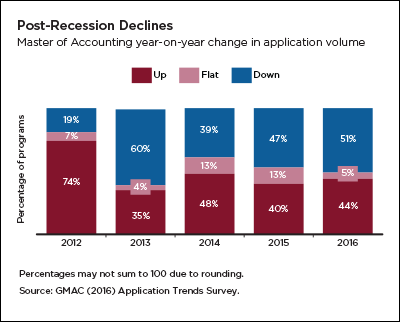Nearly half of these master’s programs report plans to reduce the size of their incoming class.

From 2008 to 2012—during the Great Recession and in its immediate aftermath—the majority of Master of Accounting programs reported rising application volumes. This likely was due in part to the unfavorable job market leading an increased number of candidates to seek a specialized degree to differentiate themselves in a competitive hiring environment. As the job market recovered, application volumes receded. This type of behavior is pretty typical for many types of business school programs—enrollments increase in economic downturns and decline when jobs become more plentiful. Even so, as the results of the
2016 Application Trends Survey show, Master of Accounting programs have now had four consecutive years with less than half of programs reporting application volume growth.

This year, many programs (48%) reacted by reporting plans to reduce the size of their 2016 incoming class. On average, programs with declining applications planned to seat four fewer students in 2016 compared with last year. Programs with growing application volumes, on the other hand, planned to increase their 2016–2017 class size by three students, on average. Despite the prevailing trends of reduced application volumes, 9 in 10 (94%) programs received more applications than seats available. Notably, program size seems to be related to application volumes. More than half (52%) of programs with 50 or more students report application volume growth in 2016, compared with just 38 percent of programs with less than 50 students.
In the United States—where most Master of Accounting programs are located—there is one regional bright spot. Half (50%) of the programs in the West—including the states of Arizona, California, Colorado, Nevada, New Mexico, Oregon, Utah, and Washington—report growing application volumes. In contrast, just 30 percent of programs in the Northeast—including the states of Connecticut, Maine, Massachusetts, New Hampshire, New Jersey, New York, Pennsylvania, and Rhode Island—report growing application volumes. Forty-seven percent of programs in the South and 42 percent of programs in the Midwest report growing application volumes.
Women continue to dominate the applicant pool for Master of Accounting programs, representing 61 percent of applicants compared with 39 percent representation for men in the 2016–2017 class. Overall, 38 percent of Master of Accounting programs report increasing application volumes for women in 2016 compared with 2015 and 34 percent report growing application volume for men. This year domestic candidates represent 55 percent of the applicant pool for Master of Accounting programs and international candidates represent 45 percent. Overall, 44 percent of Master of Accounting programs report increased application volumes from domestic candidates this year compared with 2015; 39 percent report receiving more applications from international candidates.
For more information on application trends to graduate business school programs, including data related to tuition assistance and recruitment and outreach, download the 2016 Application Trends Survey Report at gmac.com/applicationtrends.